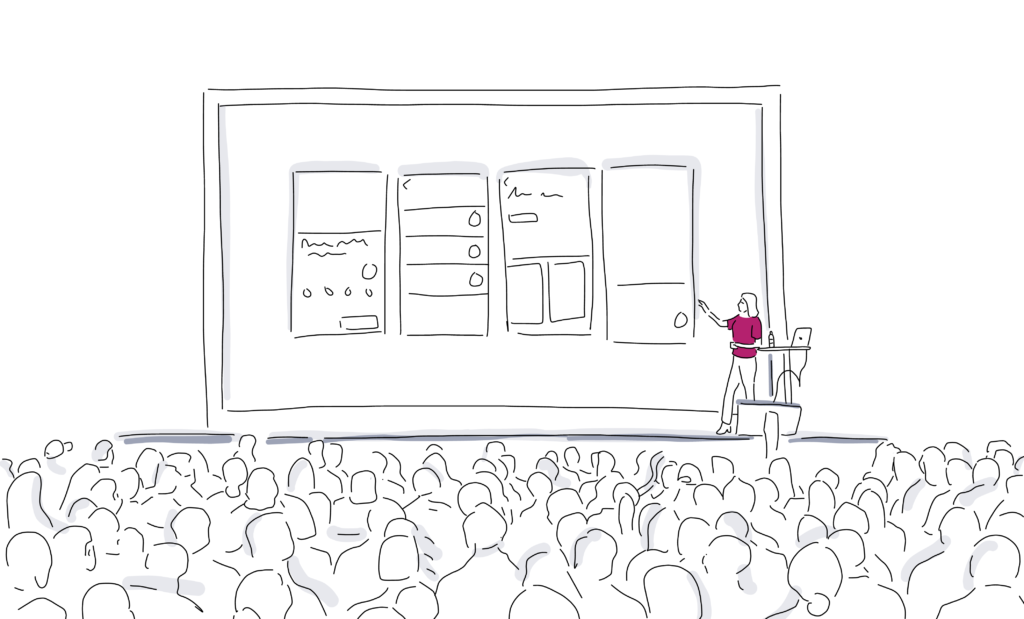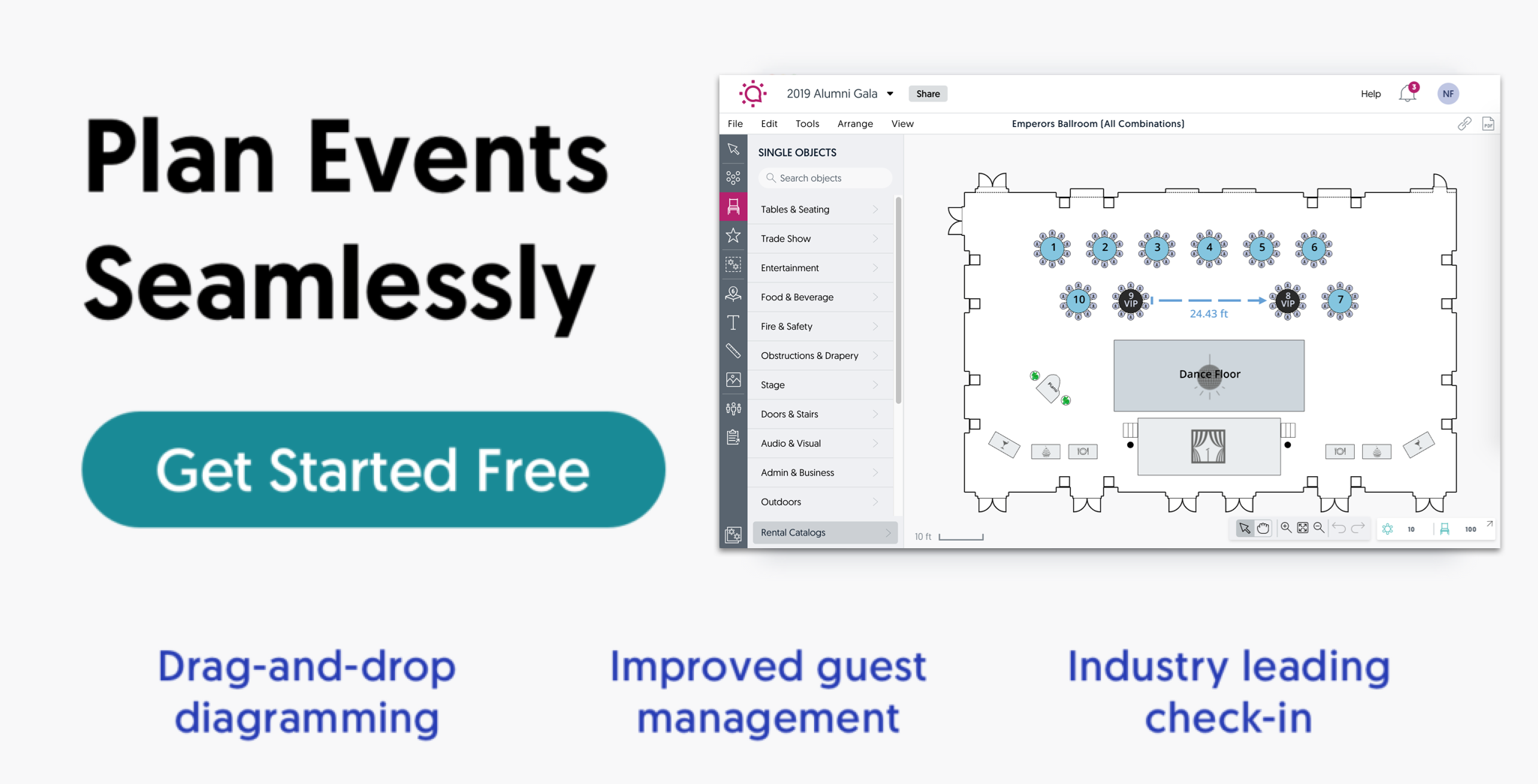
The Complete Guide to Event Stage Design
A well-designed stage can help you stand out from the crowd and can be a make or break factor of the experience for your audience. But before you commit to an event stage design, it’s important to consider all the factors that go into creating one. Support your event goals and impress your audience with the following guide.
Whether you’re an event planning pro or a total beginner, you have the power to create your own stage design simply by mastering the basic concepts of production design. If you don’t have the budget to hire a stage designer, you can use any of the ideas in our guide below to create a simple yet effective event stage design for your next gathering.
What is event stage design?
Event stage design is the process of adding production elements to a presentation space. The goal is to make the stage look the best that it can while also improving the overall attendee experience. You may design matching spaces across all of your stages or create an entirely new setup for each space ” the choice is yours.
There are both practical and aesthetic elements to event stage design. These all come together to create the backdrop for which your demonstrations, lectures, and workshops take place.
How is it different from event design?
Event design is the process of bringing the artistic vision of the event to life once the logistics are sorted. Event stage design focuses on only one aspect of the event design.
While your event stage design should tie into your overall event design, you may find that you’d like your presentation area to stand out from the rest of your space. If that’s the case, you have the opportunity to make it unique as long as your choices support the overall look and feel you’re going for.
What are the main components of event stage design?
Event stage design is made up of the following elements:
- Lighting
- Furniture
- A/V equipment
- Set decor and props
What tools do you use to create an event stage design?
In order to create an event stage design, you’ll need a diagramming tool like Social Tables, rules (if any) from your event venue regarding decor, a list of elements you will have access to the day of, and the exact measurements of your stage plus your audience seating areas.
How to create an unforgettable event stage design
Follow these tips on how to think about, draft, and perfect your event stage design for virtually any type of event.
1. Use audience POV
Your audience should be the main consideration in your stage design. While it’s important to keep in mind the basic elements of good stage design, which includes great lighting, it’s also important to consider the demographic of the audience. For example, while young musicians may love the strobe lights, others may not.
2. Consider the venue
Your venue may have event stage design rules already in place. For example, certain historic locations have restricted areas where you can’t do anything on property. These aren’t a disadvantage. In fact, you may find some creative ideas within these limitations that you may not have come up with in another space.
You’ll also find that some venues have permanent stages, while others have temporary locations. These details will also determine what you can or can’t do with your design.
Another surprising factor to consider is ceiling height. This will have a big visual impact on the stage. If the ceiling is low, you may want to prioritize long screens and backdrops that fill the width and maximize vertical space. If the ceiling is high, props such as well-placed vertical drapes and hanging lights can be quite impressive.
3. Apply production principles
In order to create a set and stage backdrop, the designer should first consider the basic elements of good stage design. These include simplicity, cohesion, and texture. Simplicity means having elements that are in line with the theme and not in conflict with one another. Even if your production is extravagant, there’s always room for decluttering and keeping focus on the main event.
Cohesion means using production elements that go together and support one overall look rather than throwing things together. This includes color, shape, style, etc. All aspects of the production should look like they belong together.
Texture means everything from textured materials to layouts that have elements in the background and foreground of the stage scene design. Adding texture is visually interesting and provides depth to spaces that need it.
4. Create a strategic layout
A great way to get started is to see a graphic render of the event space in relation to the desired look. This will help you get started on the right foot and help you avoid any technical issues. Social Tables, a collaborative layout tool, allows users to create 3D models of any event space. Social Tables also gives users the option to add custom room and object measurements to perfect your event stage design well before load in. This is especially important for visualizing foot paths. No matter who uses the stage, there is always some movement. Before the event even begins, make sure you plan for the flow of movement that will occur during the event by mapping out cables and other potential obstacles.
Pro tip: make sure you know all the electrical outlet locations when designing your event stage layout! This will help you properly allocate space for equipment or practical lighting that needs to be plugged in.
5. Think about lighting
A great lighting system can transform a plain canvas into a new environment full of energy and excitement. It can also control the mood of the stage and make a dramatic change to the venue.
You may choose to work with a lighting company that can help you achieve the look you’re going for. But if you go the DIY route, it’s good to start from a place of curiosity.
Ask yourself: Are there areas of the stage that need lighting? What mood would you like to achieve for this particular stage compared to the other presentation spaces or areas of the venue? How will you visually divide the space into zones using lights? For example, you may want to emphasize a portion of your event stage design while the audience is being seated by using a spotlight.
Also, the venue’s overall look should match the venue’s lighting design. For example, if the venue’s lighting showcases Edison bulbs, you can use warm colors and materials such as wood, leather, and yellow in your stage design to complement the welcoming atmosphere.
6. Incorporate technology
There are lots of ways to incorporate technology into your event stage design. From the mics you choose to the fog machine, technology is a large part of modern events and should be a big consideration during your design process.
For example, even something as simple as a tech-enabled banner can transform your event stage design. Wide digital banners are commonly used to depict multimedia content such as music videos, hype previews, and additional event promotion. These can be very engaging and memorable thanks to their large visual impact.
7. Use what’s around
Sometimes the best event stage design choice is letting the space speak for itself with just a few accessories to enhance its appearance or practicality. For example, an outdoor stage with a great view can be used as a backdrop for performances and speakers without having to add any other large set pieces.
If your space is indoors, look for natural focal points. Whether it’s an interesting chandelier or hand-carved wood trim, your venue may already be doing the heavy lifting for your event stage design if you look hard enough.
Event stage design made simple
A stage is simply the blank canvas that event planners use to create something truly special. It needs to be designed and built to take on a whole new meaning. A well-designed stage elevates the venue’s overall look while also making sure both the featured performers and audience members are completely immersed in the experience.
Up next, learn more about how to create amazing 3D stage designs that bring your ideas to life in a practical format your partners and clients can confidently sign off on.


